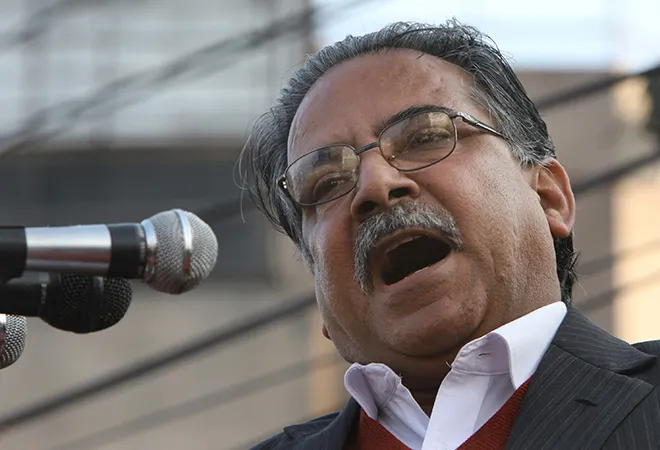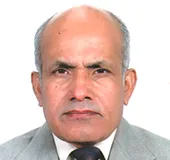-
CENTRES
Progammes & Centres
Location
How will Nepal under the new PM navigate power rivalry in the region as the room for hedging shrinks?

Nepal is often referred to as “a yam between the two boulders” as it lies between two powerful neighbours—India and China. So, for its survival, it needs to have balanced relations with both. After becoming Prime Minister of Nepal on 26 December 2022, Pushpa Kamal Dahal ‘Prachanda’ in his first interview with ABP News (India) said that he would forget the old disputes with India in his bid to strengthen Nepal’s relations with this country. He also said that all the misunderstandings between the two countries would be sorted out through dialogue and for this, he might first visit India before any other country. However, his first seven days in office indicate that the country is inching closer to one neighbour at the cost of the other.
Within hours of Prachanda becoming Prime Minister of Nepal, the Chinese technical team arrived in Kathmandu on 27 December to prepare a Detailed Project Report (DPR) for the Kathmandu (Nepal)-Kerung (China) railway project. Regarding the Kathmandu-Kerung railway, the key issue is if it has the potential to serve Nepal’s interests or that of China. Kerung in the Tibetan region of China is several thousand kilometres away from the mainland. So, not many people would travel through it. In the trade sector, Nepal imported goods worth INR 233.92 billion from China in 2020-21; while it exported goods worth only INR 1 billion to that country.
Estimates are that the Kathmandu-Kerung railway line would cost the nation US$8 billion, which is more than a fourth of the country’s total GDP. For a lower-income country like Nepal, it will not be possible to repay the interest and the principal amount for this project.
Estimates are that the Kathmandu-Kerung railway line would cost the nation US$8 billion, which is more than a fourth of the country’s total GDP.
Also, this proposed rail line will have to pass through the most difficult terrain in the Himalayas for which several bridges and tunnels would have to be built. In winter, there is always heavy snowfall in the Himalayas, which could disrupt railway services if the track is not cleared. Even if it is done, it will prove to be a costly affair. The environmental impact of this project is another challenge. Considering the huge cost involved in the construction of the project, the Sher Bahadur Deuba-led Nepali Congress government in Nepal sent a message to China in 2021 that it would not have any problem accepting the project like the Kathmandu-Kerung railway from China under Belt Road Initiative (BRI) provided it comes in grants. Will China be able to gift this railway to Nepal in grants is a question?
On the third day 28 December 2022, China opened the Rasuwagadi (Nepal)-Kerung (China) border which was lying closed for nearly three years since January 2020 when COVID-19 cases started picking up. Perhaps, this was a symbol of welcome to Prime Minister Dahal. But it is not known why China could not open Tatopani border which is still lying closed ever since 2015 when Nepal was hardest hit by the earthquake. Similarly, other crossing points between Nepal and Tibet are not opened, though the border inhabitants of the two countries are facing severe hardships due to this.
And, on the seventh day, 1 January 2023, Prime Minister Prachanda inaugurated the Pokhara International Airport in western Nepal in a grand ceremony. The Airport was constructed with a soft loan from China EXIM Bank in March 2016. It is the third international airport, the other two being Gautam Buddha International Airport in Bhairahawa and Tribhuvan International Airport in Kathmandu.
Unfortunately, there is no hope for the Pokhara International Airport to come into operation, at least shortly after its inability to attract foreign airlines. Since it is constructed with Chinese loans, it is unlikely that India would allow its airspace to any foreign airlines for this purpose. India has a clear policy that it would not entertain any project in Nepal that is constructed with Chinese aid. In such a case, the Pokhara International Airport would fare worse than even the Gautam Buddha International Airport in Bhairahawa, which could get only Jazeera Airways of Kuwait since it started operation in May 2022 and now even that operation is also stopped.
The Airport was constructed with a soft loan from China EXIM Bank in March 2016. It is the third international airport, the other two being Gautam Buddha International Airport in Bhairahawa and Tribhuvan International Airport in Kathmandu.
For reasons unknown, a controversy was created a day before the inauguration of Pokhara International Airport on 1 January when the Chinese Embassy on its Twitter account mentioned, “This
While inaugurating the Pokhara International Airport, Prime Minister PK Dahal raised another controversy when he said that the government would construct a new international airport in Nijgadh at any cost. When the future of the two recently built international airports, including Gautam Buddha International Airport and Pokhara International Airport is uncertain, what is the sense of building altogether a fourth international airport in Nijgad? Regarding this, Nepal’s Supreme Court has already ordered the government to scrap the decision to construct a new international airport in Nijgad because the ecological cost of US$3.5 billion of Nijgad Airport was ignored due to the lack of an Environment Impact Assessment (EIA).
People don’t understand why the Embassy called this Airport its flagship project when it was designed several years before the BRI was conceived.
It cannot be denied that the development of infrastructural facilities like roads, railways, and airways is crucial as they are effective means of connectivity. But it does not mean that infrastructural facilities should be built haphazardly. Any attempt to build infrastructures without considering their rationale might prove catastrophic. Towards this end, Nepal has already made a heavy investment in these two mega international airport projects through loans in which the prospect of recovery of loans is bleak. As such, Nepal is likely to incur a huge economic loss. Amidst this situation, any attempt to make the fourth international airport in Nijgad or construct the Kerung-Kathmandu railway project through the Himalayas could be disastrous. Prachanda who has become Prime Minister for the third time now needs to understand these realities and through his actions, he should exhibit that any project supported by one country does not go against the interest of the other.
The views expressed above belong to the author(s). ORF research and analyses now available on Telegram! Click here to access our curated content — blogs, longforms and interviews.

Hari Bansh Jha was a Visiting Fellow at ORF. Formerly a professor of economics at Nepal's Tribhuvan University, Hari Bansh’s areas of interest include, Nepal-China-India strategic ...
Read More +